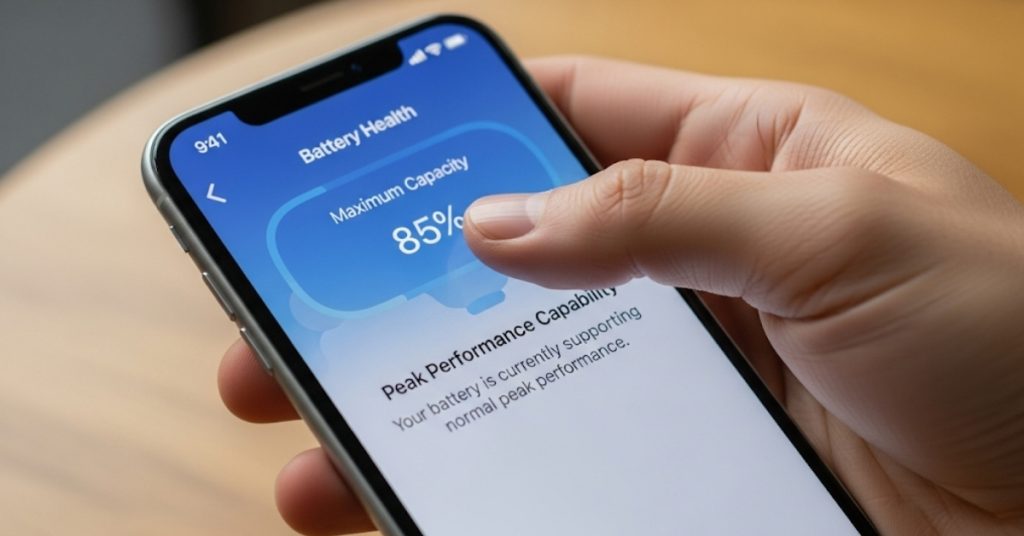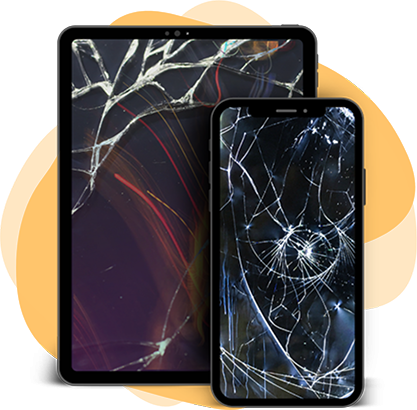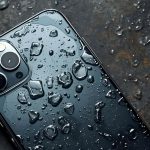No products in the cart.
iPhone battery health thresholds that signal a replacement
Wondering when it’s time to replace your iPhone battery? Understanding iPhone battery health thresholds is the key to knowing whether your device still performs well or needs a new battery. At Phone Expert, we explain charge cycles, Apple’s built-in performance management, and why many users choose replacement once their battery drops near 80%. With our expert testing and safe replacement services, you’ll know exactly when your iPhone battery needs attention. Book a quick battery check today.

What Battery Health means on iPhone
Battery Health shows remaining capacity versus when the battery was new so you can judge runtime, stability and replacement timing.
Your iPhone estimates how much charge the current battery can hold compared with its factory capacity. A reading of 90 percent means the battery stores roughly nine-tenths of its original charge. As cells age, capacity falls and peak current delivery drops, which can trigger slowdowns or shutdowns. We interpret the reading in context; you decide based on your daily runtime.
We run a health check, you get plain numbers. We review your usage, you get a personalised recommendation. Example: a light user at 82 percent may still finish a day, while a power user at 85 percent may struggle by mid-afternoon.
Quick definitions
- Maximum capacity: Remaining charge vs new (percent).
- Peak performance capability: Whether the phone can supply bursts without shutdown.
- Service recommendation: iOS notice that a battery’s health is significantly degraded.

Don't Let A Broken Phone Hold You Back
Look no further! Our comprehensive price list covers all major brands and models, ensuring that you can easily find the repair cost for your specific phone. Pleas check our price list for details
Replacement threshold on iPhone
Replacing near 80 percent capacity is sensible, or earlier if you see shutdowns, rapid drain or a service alert in Battery Health.
Apple indicates iPhone batteries are expected to retain significant capacity for many cycles, but once the Battery Health indicator drops to around 80 percent, many users can no longer get a full day. If iOS applies performance management or flags “Service,” replacement restores peak performance and predictable runtime. We test your device, you get a pass-or-replace answer.
We fit a quality battery, you regain performance headroom. Example: an iPhone 11 at 79 percent that shuts down during camera bursts benefits from immediate replacement; an iPhone 12 at 83 percent with stable behaviour can be monitored monthly.

Decision guide
| Situation | Threshold to act | Why it matters |
|---|---|---|
| Battery health ≤ 80% | Replace | Runtime and peak current drop noticeably |
| Shutdowns or throttle note | Replace | Performance management reduces speed |
| 81–85% with fast drain | Consider | Heavy use exposes ageing earlier |
| > 85% and stable | Monitor | Check Battery Health monthly |
Simple questions
How low should iPhone battery health be before replacing?
Around 80 percent suits most users, but replace sooner if shutdowns or a service message appears.
Does performance management mean I need a new battery now?
If it’s active due to shutdowns, a fresh battery removes the throttle and restores normal bursts.
Will a new battery restore full performance?
Yes. Replacing a degraded battery restores peak current so apps, camera and 5G feel responsive again.
Can I wait if I am at 82 percent?
If runtime is acceptable and no shutdowns occur, monitor and revisit in a month.
Performance management basics
iOS reduces peak performance to prevent unexpected shutdowns when an aged battery cannot supply sudden current on demand.
When voltage sags under load, iOS manages peak tasks so the phone stays on. You may notice slower app launches, reduced frame rates or dimmer backlight. This is normal chemistry meeting smart software. We replicate load in testing, you see whether throttling is active. We replace the battery when needed, you remove the bottleneck.
We run camera bursts and CPU spikes, you get real-world results. Example: an iPhone 8 crashes in cold weather at 30 percent; after replacement, the same tasks complete without shutting down.
What to watch
- Slower launches after cold starts or low charge.
- Shutdowns during camera or navigation.
- “Performance management applied” inside Battery Health.
Charge cycles and battery ageing
Lithium-ion loses capacity with full charge cycles, and heat plus deep discharge accelerates degradation over time.
A cycle equals 100 percent of use, not one plug-in; two half-day top-ups can equal one cycle. High temperatures, frequent 0–100 swings and fast charging in hot environments all accelerate wear. We map your pattern, you get a tailored plan to slow the drop. You keep the phone cooler, the battery ages more slowly.

We explain cycle count, you choose habits that fit your day. Example: swapping a hot dashboard fast-charge for a shaded, slower overnight charge noticeably slows health decline.
Ageing factors
- Cycles: Higher count correlates with capacity loss.
- Heat: Hot cars and sunlit dashboards accelerate battery ageing.
- Depth: Repeated deep discharges stress electrodes.
Signs your iPhone battery needs replacement
Short runtime, unexpected shutdowns, swelling or an iOS service alert are clear indicators to replace your iPhone battery.
You know your normal day. If two mid-day top-ups have become standard, or the phone restarts under camera use, the battery likely cannot deliver peaks. If the case lifts or the screen edges rise, stop charging and seek service immediately. We assess the device, you get a safe, data-aware replacement.
We inspect seals and connectors, you retain features like True Tone after calibration. Example: an iPhone XR that dies during video calls at 25 percent regains a full shift after a new battery.
Common indicators
- Battery health drops below 80 percent.
- Performance management keeps re-engaging.
- Charging feels normal but drain is fast.
- Visible swelling or screen lift.
Model notes from iPhone 6 to iPhone 15
All models share the 80 percent decision point, but earlier models show shutdowns sooner while newer ones manage peaks better.
iPhone 6, 7, 8 and early SE models have less headroom, so ageing cells can trigger shutdowns earlier. iPhone XR, 11 and 12 series improved power delivery, yet camera, gaming and 5G still stress older cells. iPhone 14 and 15 are efficient, but the same chemistry rules apply. We match parts to model, you keep expected features after the swap.
We test per model, you get specific advice. Example: an iPhone 7 at 84 percent with shutdowns is a replacement candidate; an iPhone 13 at 82 percent without symptoms can wait.
At-a-glance
- iPhone 6/7/8/SE: Earlier shutdown risk; benefit from timely replacement.
- iPhone XR/11/12: Larger cells help, but 80 percent still guides action.
- iPhone 14/15: Efficient chips; replacement restores peak bursts.
DIY battery replacement vs service
DIY can save on labour, but professional service protects parts quality, water-resistance and data integrity. Batteries are held with strong adhesive and sit near delicate flex cables. A slip can damage the display, Face ID or seals. Our technicians use quality parts and proper adhesives, then run post-fit diagnostics. You avoid repeat work and keep the phone’s features intact. We manage data-safe workflows, you keep photos and settings. Example: a DIY job tears a sensor cable; a pro job finishes in one visit with a tested seal.Compare options
We manage data-safe workflows, you keep photos and settings. Example: a DIY job tears a sensor cable; a pro job finishes in one visit with a tested seal.Compare options| Option | Pros | Cons |
|---|---|---|
| DIY battery replacement | Lower upfront cost | Risk to screen, Face ID and seals |
| Professional replacement | Tested parts, calibrated, warranty | Higher cost than DIY |
Battery testing and health measurements
Combine capacity percentage, cycle count and load testing to confirm whether replacement is necessary now or later.
We start with Battery Health and cycle count, then run controlled load to see voltage behaviour under stress. Numbers plus symptoms make the decision clear. If health is borderline, we re-test after a full charge and a software update. You get transparent results and a timed plan.
We capture before-and-after stats, you see improvement after replacement. Example: an iPhone 11 falls from 3.85 V to shutdown on camera bursts; the new battery holds voltage and completes the test.
Testing checklist
- Record Battery Health percentage and cycle count.
- Test under camera and CPU load for sag.
- Re-test after a full charge and update.
- Decide using data plus daily use.

Not Sure About A Repair You Need?
Whether you’re dealing with a cracked screen, battery issues, or software glitches, we’ve got you covered. Get a FREE quote today!
Ways to extend battery life safely
Keep charge between roughly 20 and 80 percent, avoid heat, use quality chargers and keep iOS current to slow degradation.
Gentle charging and cooler conditions help every iPhone model. Optimised charging features can reduce time spent at 100 percent. Avoid hot windscreens and thick cases during high-rate charging. We review accessories, you charge with confidence.
Adopt small changes, you see slower decline. Example: removing a heavy case during fast charging drops temperature and stabilises health over months.

Practical tips
- Prefer shorter top-ups; avoid frequent 0–100 swings.
- Charge off-dashboard; keep the phone shaded and cool.
- Update iOS for battery management improvements.
- Use reputable chargers and certified cables.
When not to replace yet
If battery health sits above 80 percent, performance is stable and no service alert appears, monitoring is a better choice than replacing now.
Replacing too early wastes money and materials. Set a monthly reminder to check Battery Health and note end-of-day percentage. If your iPhone still makes a full day and performance feels normal, wait. We can schedule a check-in to reassess as numbers change.
We track trends, you choose the timing. Example: an iPhone 13 at 86 percent finishing days with 25 percent left can revisit in three months.

Hold-off criteria
- Health ≥ 85 percent and full-day runtime.
- No shutdowns during camera or calls.
- Temperatures stay normal in everyday use.
How urgent is a battery change
Replace urgently if the battery swells, the phone shuts down under light load or you rely on it for safety-critical work.
Swelling can damage the display and create safety risk; stop charging and seek service immediately. Frequent shutdowns can corrupt data and calls. If you depend on your phone for business or travel, plan a prompt replacement to avoid outages. We triage urgent cases to minimise downtime.
We prioritise safety, you protect your device and data. Example: a screen lifting at one corner signals swelling; we secure the device and replace the battery promptly.
Urgency scale
- Immediate: Swelling or burning smell.
- Soon: ≤ 80 percent with fast drain or throttling.
- Monitor: ≥ 85 percent and stable behaviour.
Book iPhone battery replacement in Australia
A short diagnostic confirms whether your current battery still fits your needs or a replacement will restore full performance.
We service iPhone 6 through iPhone 15 and later, including iPhone 8, iPhone XR, iPhone 11, iPhone 12 and iPhone 14 series. We back up where requested, then replace and calibrate the battery so your iPhone performs as expected. Contact Phone Expert to book a same-day battery check and get your iPhone battery replaced with confidence today.

Book Online &
Save $10 on Your Mobile Phone Repair
By booking online, you get an exclusive $10 discount on your repair cost. Don’t miss out on this special offer!






